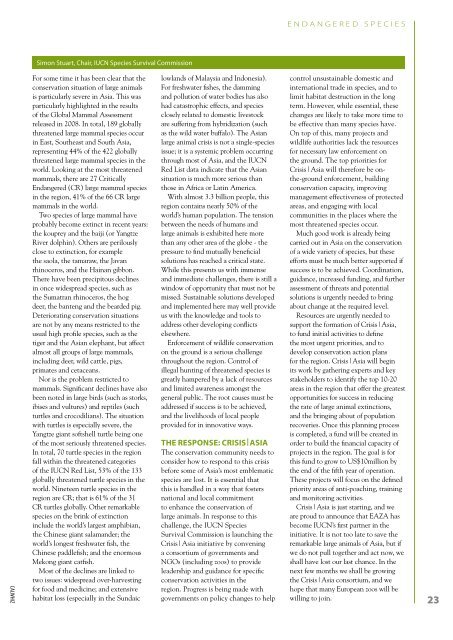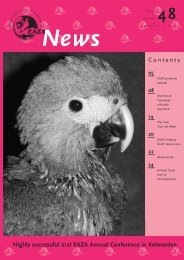Spring 2010 - European Association of Zoos and Aquaria
Spring 2010 - European Association of Zoos and Aquaria
Spring 2010 - European Association of Zoos and Aquaria
You also want an ePaper? Increase the reach of your titles
YUMPU automatically turns print PDFs into web optimized ePapers that Google loves.
calwhiz<br />
Simon Stuart, Chair, IUCN Species Survival Commission<br />
For some time it has been clear that the<br />
conservation situation <strong>of</strong> large animals<br />
is particularly severe in Asia. This was<br />
particularly highlighted in the results<br />
<strong>of</strong> the Global Mammal Assessment<br />
released in 2008. In total, 189 globally<br />
threatened large mammal species occur<br />
in East, Southeast <strong>and</strong> South Asia,<br />
representing 44% <strong>of</strong> the 422 globally<br />
threatened large mammal species in the<br />
world. Looking at the most threatened<br />
mammals, there are 27 Critically<br />
Endangered (CR) large mammal species<br />
in the region, 41% <strong>of</strong> the 66 CR large<br />
mammals in the world.<br />
Two species <strong>of</strong> large mammal have<br />
probably become extinct in recent years:<br />
the kouprey <strong>and</strong> the baiji (or Yangtze<br />
River dolphin). Others are perilously<br />
close to extinction, for example<br />
the saola, the tamaraw, the Javan<br />
rhinoceros, <strong>and</strong> the Hainan gibbon.<br />
There have been precipitous declines<br />
in once widespread species, such as<br />
the Sumatran rhinoceros, the hog<br />
deer, the banteng <strong>and</strong> the bearded pig.<br />
Deteriorating conservation situations<br />
are not by any means restricted to the<br />
usual high pr<strong>of</strong>ile species, such as the<br />
tiger <strong>and</strong> the Asian elephant, but affect<br />
almost all groups <strong>of</strong> large mammals,<br />
including deer, wild cattle, pigs,<br />
primates <strong>and</strong> cetaceans.<br />
Nor is the problem restricted to<br />
mammals. Significant declines have also<br />
been noted in large birds (such as storks,<br />
ibises <strong>and</strong> vultures) <strong>and</strong> reptiles (such<br />
turtles <strong>and</strong> crocodilians). The situation<br />
with turtles is especially severe, the<br />
Yangtze giant s<strong>of</strong>tshell turtle being one<br />
<strong>of</strong> the most seriously threatened species.<br />
In total, 70 turtle species in the region<br />
fall within the threatened categories<br />
<strong>of</strong> the IUCN Red List, 53% <strong>of</strong> the 133<br />
globally threatened turtle species in the<br />
world. Nineteen turtle species in the<br />
region are CR; that is 61% <strong>of</strong> the 31<br />
CR turtles globally. Other remarkable<br />
species on the brink <strong>of</strong> extinction<br />
include the world’s largest amphibian,<br />
the Chinese giant salam<strong>and</strong>er; the<br />
world’s longest freshwater fish, the<br />
Chinese paddlefish; <strong>and</strong> the enormous<br />
Mekong giant catfish.<br />
Most <strong>of</strong> the declines are linked to<br />
two issues: widespread over-harvesting<br />
for food <strong>and</strong> medicine; <strong>and</strong> extensive<br />
habitat loss (especially in the Sundaic<br />
lowl<strong>and</strong>s <strong>of</strong> Malaysia <strong>and</strong> Indonesia).<br />
For freshwater fishes, the damming<br />
<strong>and</strong> pollution <strong>of</strong> water bodies has also<br />
had catastrophic effects, <strong>and</strong> species<br />
closely related to domestic livestock<br />
are suffering from hybridization (such<br />
as the wild water buffalo). The Asian<br />
large animal crisis is not a single-species<br />
issue; it is a systemic problem occurring<br />
through most <strong>of</strong> Asia, <strong>and</strong> the IUCN<br />
Red List data indicate that the Asian<br />
situation is much more serious than<br />
those in Africa or Latin America.<br />
With almost 3.3 billion people, this<br />
region contains nearly 50% <strong>of</strong> the<br />
world’s human population. The tension<br />
between the needs <strong>of</strong> humans <strong>and</strong><br />
large animals is exhibited here more<br />
than any other area <strong>of</strong> the globe - the<br />
pressure to find mutually beneficial<br />
solutions has reached a critical state.<br />
While this presents us with immense<br />
<strong>and</strong> immediate challenges, there is still a<br />
window <strong>of</strong> opportunity that must not be<br />
missed. Sustainable solutions developed<br />
<strong>and</strong> implemented here may well provide<br />
us with the knowledge <strong>and</strong> tools to<br />
address other developing conflicts<br />
elsewhere.<br />
Enforcement <strong>of</strong> wildlife conservation<br />
on the ground is a serious challenge<br />
throughout the region. Control <strong>of</strong><br />
illegal hunting <strong>of</strong> threatened species is<br />
greatly hampered by a lack <strong>of</strong> resources<br />
<strong>and</strong> limited awareness amongst the<br />
general public. The root causes must be<br />
addressed if success is to be achieved,<br />
<strong>and</strong> the livelihoods <strong>of</strong> local people<br />
provided for in innovative ways.<br />
The Response: CRisis|AsiA<br />
The conservation community needs to<br />
consider how to respond to this crisis<br />
before some <strong>of</strong> Asia’s most emblematic<br />
species are lost. It is essential that<br />
this is h<strong>and</strong>led in a way that fosters<br />
national <strong>and</strong> local commitment<br />
to enhance the conservation <strong>of</strong><br />
large animals. In response to this<br />
challenge, the IUCN Species<br />
Survival Commission is launching the<br />
Crisis|Asia initiative by convening<br />
a consortium <strong>of</strong> governments <strong>and</strong><br />
NGOs (including zoos) to provide<br />
leadership <strong>and</strong> guidance for specific<br />
conservation activities in the<br />
region. Progress is being made with<br />
governments on policy changes to help<br />
endangered species<br />
control unsustainable domestic <strong>and</strong><br />
international trade in species, <strong>and</strong> to<br />
limit habitat destruction in the long<br />
term. However, while essential, these<br />
changes are likely to take more time to<br />
be effective than many species have.<br />
On top <strong>of</strong> this, many projects <strong>and</strong><br />
wildlife authorities lack the resources<br />
for necessary law enforcement on<br />
the ground. The top priorities for<br />
Crisis|Asia will therefore be onthe-ground<br />
enforcement, building<br />
conservation capacity, improving<br />
management effectiveness <strong>of</strong> protected<br />
areas, <strong>and</strong> engaging with local<br />
communities in the places where the<br />
most threatened species occur.<br />
Much good work is already being<br />
carried out in Asia on the conservation<br />
<strong>of</strong> a wide variety <strong>of</strong> species, but these<br />
efforts must be much better supported if<br />
success is to be achieved. Coordination,<br />
guidance, increased funding, <strong>and</strong> further<br />
assessment <strong>of</strong> threats <strong>and</strong> potential<br />
solutions is urgently needed to bring<br />
about change at the required level.<br />
Resources are urgently needed to<br />
support the formation <strong>of</strong> Crisis|Asia,<br />
to fund initial activities to define<br />
the most urgent priorities, <strong>and</strong> to<br />
develop conservation action plans<br />
for the region. Crisis|Asia will begin<br />
its work by gathering experts <strong>and</strong> key<br />
stakeholders to identify the top 10-20<br />
areas in the region that <strong>of</strong>fer the greatest<br />
opportunities for success in reducing<br />
the rate <strong>of</strong> large animal extinctions,<br />
<strong>and</strong> the bringing about <strong>of</strong> population<br />
recoveries. Once this planning process<br />
is completed, a fund will be created in<br />
order to build the financial capacity <strong>of</strong><br />
projects in the region. The goal is for<br />
this fund to grow to US$10million by<br />
the end <strong>of</strong> the fifth year <strong>of</strong> operation.<br />
These projects will focus on the defined<br />
priority areas <strong>of</strong> anti-poaching, training<br />
<strong>and</strong> monitoring activities.<br />
Crisis|Asia is just starting, <strong>and</strong> we<br />
are proud to announce that EAZA has<br />
become IUCN’s first partner in the<br />
initiative. It is not too late to save the<br />
remarkable large animals <strong>of</strong> Asia, but if<br />
we do not pull together <strong>and</strong> act now, we<br />
shall have lost our last chance. In the<br />
next few months we shall be growing<br />
the Crisis|Asia consortium, <strong>and</strong> we<br />
hope that many <strong>European</strong> zoos will be<br />
willing to join.<br />
23

















